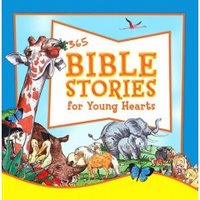365 Bible Stories for Young Hearts

365 Bible Stories for Young Hearts
(Crossway Books, 2006), hb., 440 pp.
This is a nicely illustrated story Bible designed to cover the Bible in one year. Breaking it up into 365 stories is a helpful device for families. My wife has been using this book for our 4 year old when she has Bile reading time with the older boys. Our 4 year old can follow along to some extent.
The illustrations are nicely done. Many of them also appear in the ESV Children’s Bible. Alan Parry is one of our favorite illustrators.
As with most story Bible’s most attention is given to the narrative portions of the Bible. It is just more difficult to handle the letters in a story Bible. Still 4 stories are given to Paul’s letters, one to Hebrews and one to Revelation.
This is a good story Bile for use with younger children and the set up can be helpful for families in establishing a regular Bible time with younger children.


